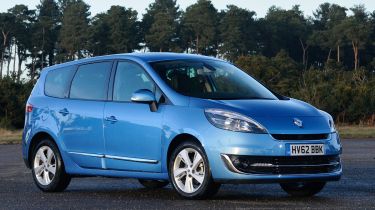Renault Grand Scenic 1.5 dCi
The established Renault Grand Scenic majors on space and efficiency
Acres of space and lots of family-friendly touches give the Grand Scenic the edge in this test. The 1.5-litre dCi diesel isn’t the smoothest or most powerful engine around, but it’s clean and economical, while Renault’s great-value 4+ service and warranty deal seals the victory.
Seven-seat MPVs are a Renault speciality, and the Scenic became one of the first compact models to have extra seats when the extended Grand launched nearly 10 years ago.
One area where the Scenic loses out to the Toyota is looks. It follows function rather than form, although a forthcoming facelift will see the bluff front end replaced by a bold new Clio-inspired nose. Further back, the upright lines are pure MPV, with only the boomerang-shaped LED tail-lights providing any visual impact.
But that squared-off look translates into a cavernous interior with headroom to spare. The cabin is bright and airy, while the part-leather seats are comfortable. Up front, the centrally mounted instrument display is a full-colour digital affair, but our Dynamique TomTom model’s standard sat-nav screen is small and set well back in the dash, making it harder to read than the Verso’s screen.
Another issue is the remote control – it’s not suitable for use while driving, and its pebble shape means it slips out of your hands too easily. It sits in a special slot fitted to one of the cup-holders, but it’s positioned low on the floor, so is impossible to reach while on the move. Fortunately, all its functions are doubled up on the BMW iDrive-style controller on the centre console.
Used - available now

2023 Peugeot
3008
27,941 milesAutomaticDiesel1.5L
Cash £18,497
2024 Honda
HR-V Hybrid
18,716 milesAutomaticPetrol1.5L
Cash £24,206
2020 Audi
Q2
33,244 milesAutomaticPetrol1.5L
Cash £18,892
2021 Toyota
Yaris Cross
22,062 milesAutomaticPetrol1.5L
Cash £24,168The Grand Scenic scores with its practical touches. There are four under-floor storage cubbies, a space for the load cover under the boot floor and a decent glovebox, while the three middle row seats slide and recline independently. You need to take the seats out for maximum space, but the release mechanism is cumbersome and they’re heavy to lift.
When the seats are removed, you’re left with 1,863 litres of luggage capacity, easily beating the Scenic’s rivals here. The load bay is also 1,100mm wide, which is 120mm wider than the Verso’s. The third-row seats are the most spacious on this test, too.
So the Scenic has space on its side, but the 1.5-litre diesel delivers mixed results. With 109bhp, it’s the least powerful engine here, and our acceleration tests revealed a lack of pulling power. That’s worth bearing in mind if you plan to cover long distances with a full load.
Our car’s ride proved disappointing, too: despite decent composure through corners, it fidgeted over bumps and never felt settled. The 17-inch alloys certainly played their part in that, but lifeless steering also contributed to a pretty lacklustre driving experience.
Still, the 47.7mpg Scenic had the best economy on test, plus the lowest emissions. Add Renault’s 4+ ownership package, and it’s an attractive choice. But it’s pricier than the Verso, and to match the Toyota’s performance you have to shell out more for the 1.6 dCi model.







